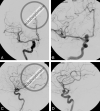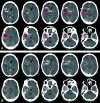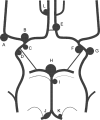Reporting standards for endovascular repair of saccular intracranial cerebral aneurysms
- PMID: 20075104
- PMCID: PMC7964049
Reporting standards for endovascular repair of saccular intracranial cerebral aneurysms
Abstract
Background and purpose: The goal of this article is to provide consensus recommendations for reporting standards, terminology, and written definitions when reporting on the radiological evaluation and endovascular treatment of intracranial, cerebral aneurysms. These criteria can be used to design clinical trials, to provide uniformity of definitions for appropriate selection and stratification of patients, and to allow analysis and meta-analysis of reported data.
Methods: This article was written under the auspices of the Joint Writing Group of the Technology Assessment Committee, Society of NeuroInterventional Surgery, Society of Interventional Radiology; Joint Section on Cerebrovascular Neurosurgery of the American Association of Neurological Surgeons and Congress of Neurological Surgeons; and Section of Stroke and Interventional Neurology of the American Academy of Neurology. A computerized search of the National Library of Medicine database of literature (PubMed) from January 1991 to December 2007 was conducted with the goal to identify published endovascular cerebrovascular interventional data about the assessment and endovascular treatment of cerebral aneurysms useful as benchmarks for quality assessment. We sought to identify those risk adjustment variables that affect the likelihood of success and complications. This article offers the rationale for different clinical and technical considerations that may be important during the design of clinical trials for endovascular treatment of cerebral aneurysms. Included in this guidance article are suggestions for uniform reporting standards for such trials. These definitions and standards are primarily intended for research purposes; however, they should also be helpful in clinical practice and applicable to all publications.
Conclusions: The evaluation and treatment of brain aneurysms often involve multiple medical specialties. Recent reviews by the American Heart Association have surveyed the medical literature to develop guidelines for the clinical management of ruptured and unruptured cerebral aneurysms. Despite efforts to synthesize existing knowledge on cerebral aneurysm evaluation and treatment, significant inconsistencies remain in nomenclature and definition for research and reporting purposes. These operational definitions were selected by consensus of a multidisciplinary writing group to provide consistency for reporting on imaging in clinical trials and observational studies involving cerebral aneurysms. These definitions should help different groups to publish results that are directly comparable.
Figures






Republished from
-
Reporting standards for endovascular repair of saccular intracranial cerebral aneurysms.Stroke. 2009 May;40(5):e366-79. doi: 10.1161/STROKEAHA.108.527572. Epub 2009 Feb 26. Stroke. 2009. PMID: 19246711 Review.
References
-
- Johnston SC, Higashida RT, Barrow DL, Caplan LR, Dion JE, Hademenos G, Hopkins LN, Molyneux A, Rosenwasser RH, Vinuela F, Wilson CB. Recommendations for the endovascular treatment of intracranial aneurysms: a statement for healthcare professionals from the Committee on Cerebrovascular Imaging of the American Heart Association Council on Cardiovascular Radiology. Stroke 2002; 33: 2536–2544 - PubMed
-
- Bederson JB, Awad IA, Wiebers DO, Piepgras D, Haley EC, Jr, Brott T, Hademenos G, Chyatte D, Rosenwasser R, Caroselli C. Recommendations for the management of patients with unruptured intracranial aneurysms: a statement for healthcare professionals from the Stroke Council of the American Heart Association. Stroke 2000; 31: 2742–2750 - PubMed
-
- Unruptured intracranial aneurysms—risk of rupture and risks of surgical intervention. International Study of Unruptured Intracranial Aneurysms investigators. N Engl J Med 1998; 339: 1725–1733 - PubMed
-
- Wiebers DO, Whisnant JP, Huston J, III, Meissner I, Brown RD, Jr, Piepgras DG, Forbes GS, Thielen K, Nichols D, O'Fallon WM, Peacock J, Jaeger L, Kassell NF, Kongable-Beckman GL, Torner JC. Unruptured intracranial aneurysms: natural history, clinical outcome, and risks of surgical and endovascular treatment. Lancet 2003; 362: 103–110 - PubMed
-
- Cloft HJ, Kallmes DF, Kallmes MH, Goldstein JH, Jensen ME, Dion JE. Prevalence of cerebral aneurysms in patients with fibromuscular dysplasia: a reassessment. J Neurosurg 1998; 88: 436–440 - PubMed
LinkOut - more resources
Full Text Sources
